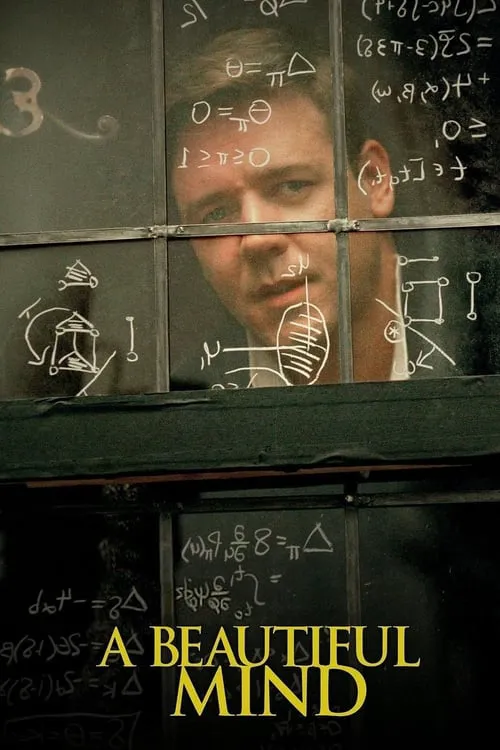A Beautiful Mind

Plot
A Beautiful Mind is a 2001 biographical drama film, directed by Ron Howard and written by Akiva Goldsman. The film tells the story of John Forbes Nash Jr., a renowned American mathematician, who struggles with paranoid schizophrenia throughout his life. Born on June 13, 1928, in Bluefield, West Virginia, John Nash is introduced as a socially awkward child prodigy who demonstrates an exceptional talent for mathematics. After enrolling at Carnegie Mellon University, Nash rapidly gains recognition for his groundbreaking work in game theory, particularly his Nash Equilibrium concept, which is considered a fundamental contribution to modern economics. As Nash's reputation grows, he is courted by Princeton University, where he becomes a rising star in the mathematics department. He catches the eye of Alicia Larde, a strong and independent woman who shares Nash's passion for literature and poetry. Despite his social awkwardness, Nash and Alicia develop a deep emotional connection, and they eventually get married in 1951. However, Nash's academic success is short-lived. In 1951, at the age of 23, he begins working on cryptography at the RAND Corporation, a think tank that secretly employs mathematicians to decipher coded messages. As Nash delves deeper into his work, he becomes increasingly fascinated with the work of Norbert Wiener, a Ukrainian-American mathematician who has developed a theory of cybernetics. As Nash's work at the RAND Corporation continues, he starts experiencing strange and disturbing visions, which he initially dismisses as stress-related. However, the visions persist, and Nash begins to suspect that someone is following him. He becomes convinced that the Soviet Union is monitoring his life and that he is somehow involved in the development of a top-secret government project. Despite his growing paranoia, Nash continues to work on his mathematical theories, which are eventually adapted and used by the U.S. government during the Cold War. He becomes embroiled in a mysterious conspiracy, which is orchestrated by a shadowy figure known only as "Charles Herman." Tragically, Nash's descent into madness accelerates as he becomes increasingly detached from reality. He begins to experience vivid mental imagery, including a recurring vision of a female figure known as "Aurora." His behavior becomes increasingly erratic, causing Alicia to become concerned for his well-being. As the years pass, Nash's reputation as a mathematician begins to fade, and he is eventually discharged from the hospital. Alicia, who has become increasingly isolated, is faced with the difficult decision of whether to leave Nash or to remain with him. The film's climax is a heart-wrenching sequence of events that sees Nash's life unravelling in a devastating way. After a tragic car accident, Nash is left severely impaired, unable to speak or communicate. Alicia remains by his side, struggling to care for him, even when Nash's condition appears terminal. The film's final act takes place five years after the accident, where we see Nash slowly beginning to recover. Alicia continues to care for him, and eventually, Nash is able to express his love for her using a unique method of communication that relies on gestures and hand signals. The film ends with Nash taking Alicia's hand, as they stand on the edge of their swimming pool. With Alicia's help, Nash is finally able to reconcile his love for her with his own tormenting voices. The film concludes on a note of hope, as Nash is finally able to break free from his mental chains, embracing his destiny as a loving husband and a great mathematician. A Beautiful Mind is a compelling biographical drama that explores the highs and lows of a brilliant mathematician's life. With extraordinary performances by Russell Crowe and Jennifer Connelly, the film masterfully captures the complex and poignant story of a man whose genius was ultimately overshadowed by his madness.
Reviews
Fiona
"My pursuit has taken me through the physical, the metaphysical, the delusional – and back." The world of a top scientist is already fascinating enough, especially when coupled with a great love. This film is not just a brilliant biography of Nash, but also a sublime celebration of love – love is infinite, love is faith, love is all logic and reason.
Bradley
I find you incredibly captivating. Your initiative suggests a shared attraction, which I deeply appreciate. However, the conventional path to trust often dictates a period of platonic courtship before intimacy. While I am open to that process, truth be told, my desire is to accelerate our connection and experience a deeper closeness with you as soon as possible.
Olivia
So you're saying don't study math, but you wouldn't listen.
Nora
Thankfully, the woman who loves him exists in reality.
Jade
What's wrong with fantasy? At least it brings three more people who love you.
Recommendations




